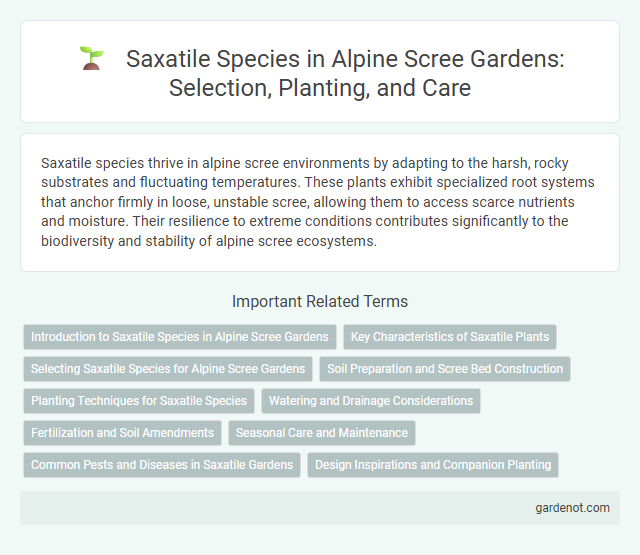Saxatile species thrive in alpine scree environments by adapting to the harsh, rocky substrates and fluctuating temperatures. These plants exhibit specialized root systems that anchor firmly in loose, unstable scree, allowing them to access scarce nutrients and moisture. Their resilience to extreme conditions contributes significantly to the biodiversity and stability of alpine scree ecosystems.
Introduction to Saxatile Species in Alpine Scree Gardens
Saxatile species in Alpine scree gardens are specially adapted to thrive in rocky, well-drained environments with minimal soil. These plants typically exhibit traits such as drought resistance, compact growth forms, and deep root systems that enable survival amid the harsh alpine conditions. Their ecological role is vital for stabilizing scree slopes and supporting biodiversity in high-altitude habitats.
Key Characteristics of Saxatile Plants
Saxatile species in alpine scree environments exhibit key characteristics such as compact growth forms, deep root systems for anchorage in rocky substrates, and succulent or hairy leaves to minimize water loss. These plants possess high tolerance to temperature fluctuations and intense solar radiation, enabling survival in harsh, nutrient-poor conditions. Adaptations like cushion-like mats and slow growth rates enhance their resilience against erosion and mechanical damage from shifting scree.
Selecting Saxatile Species for Alpine Scree Gardens
Selecting saxatile species for Alpine scree gardens requires focusing on plants that thrive in well-drained, rocky substrates with minimal soil depth. Key saxatile species such as Saxifraga oppositifolia, Androsace alpina, and Minuartia verna exhibit exceptional drought resistance and cold tolerance, making them ideal for mimicking natural alpine scree conditions. Emphasizing species with compact growth habits and vibrant flowers ensures visual appeal while maintaining ecological authenticity in alpine garden design.
Soil Preparation and Scree Bed Construction
Soil preparation for Saxatile species in alpine scree involves selecting well-drained, rocky substrates that mimic natural scree conditions, with minimal organic matter to prevent water retention. Scree bed construction must ensure a gradient of particle sizes, combining coarse gravel and larger stones to promote aeration and root stability while facilitating drainage. Attention to microtopography and soil texture replicates the harsh alpine environment, supporting the growth and survival of saxatile flora adapted to nutrient-poor, unstable substrates.
Planting Techniques for Saxatile Species
Effective planting techniques for saxatile species in Alpine scree involve replicating their natural rocky habitat with well-drained, gritty soil composed of sand, gravel, and small stones to prevent water retention and root rot. Positioning plants in crevices or between stones provides essential stability and mimics their native microclimate, promoting healthy root anchorage and moisture regulation. Incorporating slow-release fertilizers tailored for alpine plants supports nutrient uptake without overwhelming sensitive root systems in nutrient-poor scree environments.
Watering and Drainage Considerations
Saxatile species thrive in Alpine scree environments by requiring exceptional drainage to prevent root rot and mimic natural rocky slopes. Watering should be minimal and targeted, ensuring soil remains moist but not waterlogged, reflecting the sparse precipitation these plants typically encounter. Proper irrigation techniques paired with well-draining substrates promote healthy growth and resilience in challenging alpine conditions.
Fertilization and Soil Amendments
Saxatile species in alpine scree environments benefit from targeted fertilization strategies that enhance nutrient availability without disrupting natural soil balance. Organic amendments such as compost or well-decomposed plant material improve soil structure and supply essential micronutrients critical for Saxatile growth. Careful application of slow-release fertilizers optimized for low-nutrient alpine soils supports these species' survival and promotes sustainable ecological restoration in fragile scree habitats.
Seasonal Care and Maintenance
Saxatile species in alpine scree benefit from minimal seasonal care, thriving in well-drained, rocky soil with full sun exposure and protection from excessive moisture during winter. Pruning dead or damaged foliage after the growing season helps maintain plant health and encourages vigorous growth. Monitoring for pests and ensuring proper soil aeration during spring enhances overall resilience and blooming potential.
Common Pests and Diseases in Saxatile Gardens
Common pests in alpine scree saxatile gardens include aphids and spider mites, which can cause significant damage by sucking plant sap and weakening growth. Fungal diseases such as powdery mildew and root rot frequently affect saxatile species in poorly drained soils, emphasizing the need for well-aerated substrates and proper watering regimes. Regular monitoring and the use of insecticidal soaps or fungicides can help manage infestations and maintain plant health.
Design Inspirations and Companion Planting
Saxatile species found in alpine scree exhibit unique adaptations such as compact rosettes and textured foliage, inspiring eco-friendly design concepts that emphasize natural resilience and low-maintenance aesthetics. These plants thrive in well-drained, rocky substrates and pair effectively with companion species like alpine saxifrages and sedums to enhance biodiversity and soil stability. Integrating saxatile species into rock gardens and green roofs utilizes their drought tolerance and structural form to create sustainable, visually striking landscapes.
Saxatile species Infographic

 gardenot.com
gardenot.com